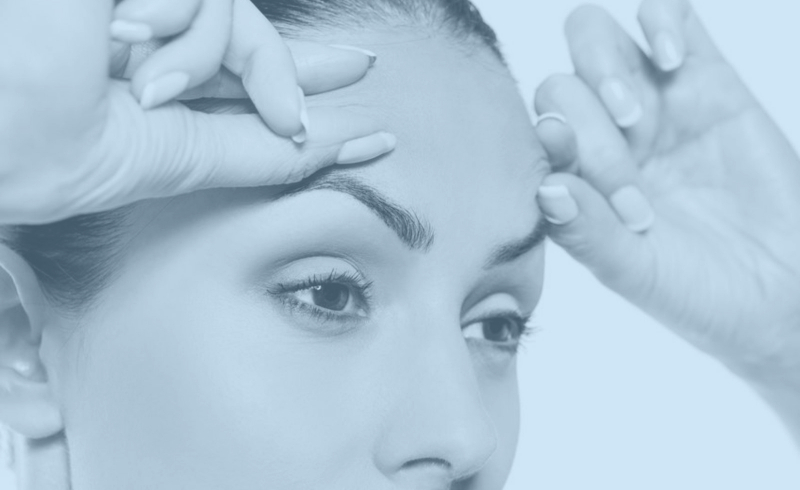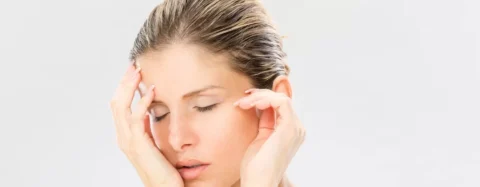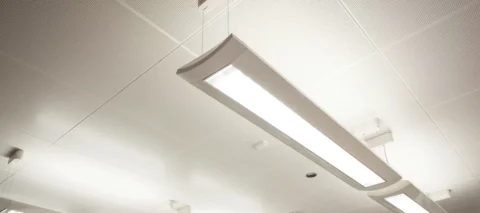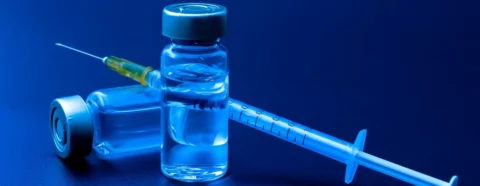Wrinkles and other facial lines slowly creep up on us all, and one of the first areas where most people will notice age-related wrinkles is along the forehead.
Horizontal forehead lines, glabellar lines (wrinkles between the eyes and eyebrows), and crow’s feet at the side of the eyes – seeing these for the first time can be disappointing, and in some cases, terrifying. Thankfully, age-related forehead wrinkles are easily treated with Botox.
So what does Botox do to your forehead? Botox treatments for the forehead can rejuvenate your forehead in just a matter of days by relaxing the muscles underneath the forehead skin. This causes the muscles to release their contraction under the skin, leading to the wrinkles clearing up and the forehead becoming smooth.
How Botox for the Forehead Works
Does Botox Remove Forehead Lines?
The general understanding of Botox is that it erases or removes facial wrinkles and lines, but this isn’t actually the case. While other treatments and facial products may treat the face at the surface-level, Botox works from underneath the skin, directly with the roots of a patient’s wrinkles and lines: the muscles.
Wrinkles such as those in the forehead are known as dynamic wrinkles, which are a result of the facial muscles beneath the skin. As we age, we spend years contracting these facial muscles – every time you smile, grimace, or do any facial expression, you force your facial muscles to contract. Dynamic wrinkles are most commonly found in the forehead, cheeks, the sides of the eyes, and between the eyebrows.
Botox in the forehead works by weakening or relaxing the facial muscles causing a patient’s dynamic wrinkles. The muscles that most contract when we perform facial expressions – muscles around the cheeks and mouth (for smiles), and muscles around the forehead and eyes (for frowns, squints, and more) – are those that are most affected by Botox.
As the facial muscles become paralyzed and relax their contraction, the appearance of wrinkles and lines in these areas, including the forehead, disappear. While there are other types of wrinkles caused by issues such as sun damage or age-related loss of elasticity, Botox is best fitted for dynamic wrinkles.
Watch how our top Botox injector at Ethos Spa performs this treatment:
How Long Does Botox Last in the Forehead?
The effects of Botox are not reversible, meaning any effect a Botox treatment may have on a patient will last until their Botox wears off. A patient can first begin to experience effects within two days after the injection, with peak effects becoming noticeable around 5-10 days after.
A single treatment of anti-wrinkle Botox for the forehead generally lasts anywhere from 3-5 months, although there are cases of Botox lasting up to a year in certain conditions. If you would like to maximize the lifespan of your Botox treatment, you can follow the following tips:
- Avoid prolonged sun exposure, and always use sunblock while outside
- Avoid wrinkling your face. Facial expressions and movements such as furrowing your brow and creasing your forehead will shorten the Botox lifespan
- Give your face up to two weeks before applying facial masks or heavy scrubs, which might interfere with the Botox properly settling in during the first few days after the treatment
- If you are unsatisfied with your treatment, don’t get Botox again soon after. Wait at least 4-8 weeks before getting another treatment of Botox, to avoid the possibility of a negative muscle reaction
How Much Botox Is Needed for Forehead?
The recommended amounts of Botox for each part of the face is set by the American Society of Plastic Surgeons. For the forehead, there are two areas of concern with wrinkles: horizontal lines in the forehead and glabellar lines between the eyes.
Women can be injected with up to 20 units of Botox for their forehead lines and up to 30 units in the glabellar area, allowing up to 50 units of Botox that can be injected into the forehead in a single treatment. For men, this can rise to 30 units in the forehead and 40 units in the glabellar area.
To make sure your body will positively react to Botox, most practitioners begin with a low-unit dosage and observing the results over 2-4 weeks. The dosage of 20 units is divided into 4 units of 5 forehead injection sites.
If you are interested in having any other surrounding area of the forehead treated with Botox, the only adjacent FDA-approved area for Botox treatment is the crow’s feet, or wrinkles beside the eyes (up to 16 units of Botox per side for men and women).
Botox Forehead Cost
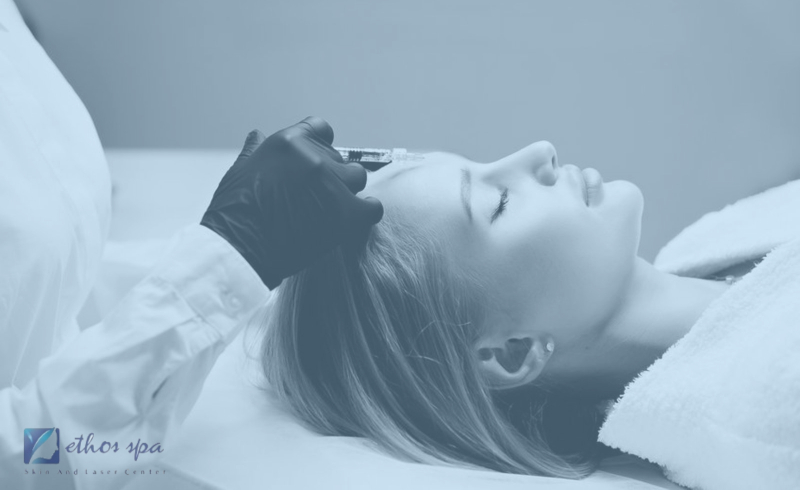
The cost of a Botox treatment will depend mostly on your location, the expertise of the doctor, and the number of Botox units used in the treatment. Each unit of Botox costs an average of $10 to $15, meaning a treatment of 20 units can cost up to $200 or $300 for the cost of units alone.
If glabellar lines are included (adding another 20 units of Botox), the total cost of units alone could rise to $400 to $600 per treatment.
Botox Forehead Side Effects
While a majority of patients who undergo Botox treatments experience little to no side effects, there are individuals who react negatively to the treatment. The possible side effects of Botox in the forehead include:
- Allergic reactions
- Itching
- Rash
- Dry mouth
- Dry Eyes
- Fever
- Injection site reactions of tenderness or swelling
- Muscle weakness/stiffness
- Appetite loss
- Water eyes
- Drowsiness
- Dizziness
- Sore throat
To avoid the possibility of side effects, it is best to have your Botox treatment performed by a trusted doctor or clinic in your area.
Ask your doctor if they recommend undergoing a low-dosage of Botox before your full Botox treatment, especially if it is your first time experiencing Botox.
Will Botox Stop My Forehead Sweating?
Aside from clearing up wrinkles, Botox is also popularly used as a treatment for hyperhidrosis (excessive sweating). The FDA has approved Botox treatments for the underarms in patients who experience severe sweating.
However, off-label treatments (not FDA-approved) of Botox in sweat palms and foreheads have found a sweat reduction of up to 75% for the lifespan of the Botox treatment. Botox stops sweating by paralyzing the neurotransmitter that signals for sweat production, and this can be effective whether in the underarms, palms, or forehead for most patients.
Does Your Forehead Feel Heavy After Botox?
One common side effect experienced by forehead Botox patients is the feeling of heaviness in the forehead. This is a result of too much Botox being injected into a certain forehead injection site.
In this case, the frontalis muscle (the forehead muscle responsible for lifting the eyebrows, which runs straight across over the eyebrows) is administered with too much Botox.
With this muscle over-paralyzed, patients can feel extra difficulty with raising the eyebrows, making the forehead feel heavy. To avoid this, make sure you only work with trusted Botox doctors and clinics.
Can Botox Cause Eyelids Droop?
Eyed droop is related to the symptoms described above, in which the frontalis muscle is over-treated with Botox, leading to the eyebrows losing all muscle support and the forehead feeling heavy.
While this may not lead to eyelid droop for most patients, some patients have excess eyelid skin, a condition commonly referred to as eye hooding. These people generally have to raise their eyebrows more to open their eyes.
When the forehead droops due to the paralysis of the frontalis muscle, it also makes it more difficult for people with excess eyelid skin to open their eyes more. This creates the appearance of droopy eyelids.
Unfortunately, the only cure for both conditions is waiting for the Botox to wear off in a few months. To avoid this, make sure to work with a trusted physician who does not overdose their Botox treatments.
Can Botox in the Forehead Lift Brows?
While the above conditions are a result of the brows drooping due to forehead muscles becoming relaxed, certain forehead Botox treatments can actually lead to the opposite, in which the brows become lifted.
To achieve lifted brows with Botox, your doctor must focus on relaxing the muscles that generally pull the brows down; the muscles that lead to glabellar lines between the eyebrows. Once these muscles are relaxed, the upper forehead muscles can naturally lift the eyebrows higher, leading to elevated brows and larger eyes (for patients who have trouble with excess eyelid skin).
Post-Procedure Questions and Tips
What to do after Botox in forehead?
While you can generally continue to live your normal life after a treatment of Botox in the forehead, there are a few things you should avoid to make sure the Botox settles in properly over the next few days after the treatment. You should avoid:
- Working out or other physical activities
- Touching, bothering, or massaging the injection sites (this could displace the Botox, producing undesired results)
- Sleeping or resting on the face 24 hours after the procedure
- Taking blood thinners such as aspirin and other medications
- Drinking alcohol (avoid alcohol for up to a week after the procedure for best results)
- Sunbathing, prolonged sun exposure, or heat lamps
Should you move your forehead after Botox?
Some patients become concerned after a forehead Botox treatment about the fact that they can still move their forehead. Patients who claim that their foreheads become paralyzed after Botox are either exaggerating their results or were given too much Botox.
The goal of the treatment should not be to immobilize any forehead movement, or else a patient will show the unwanted frozen face symptoms. A successful Botox treatment in the forehead should still result in the patient having some ability to move their forehead.
However, remember that to prolong the lifespan of your Botox, try your best to minimize movement in the forehead for the next few months.
Why does Botox make my forehead look shiny?
Some patients of forehead Botox treatments report “forehead shininess” after the treatment, however this should not be cause for concern. Botox causes paralysis of the forehead muscles that lead to wrinkles, resulting in the forehead wrinkles disappearing.
Once these disappear, the face becomes smoother, leading to a shiny or glowing appearance that is perfectly normal.
Treat Your Forehead Wrinkles With Botox Today
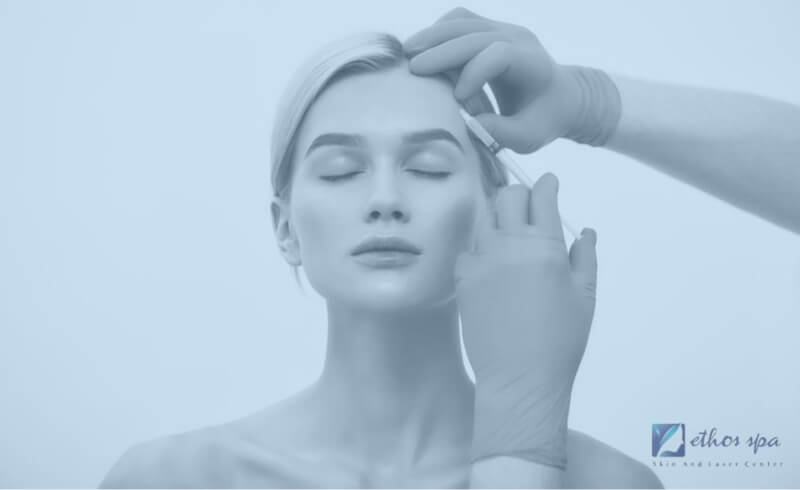
There is a reason why forehead treatment is one of the most common usages of Botox in clinics around the world: because it’s easy, effective, and safe. When performed by a trusted doctor or clinic, Botox can reverse the years on your face without a single drawback.
Contact us at Ethos Aesthetics + Wellness, the premier home for world-class trusted Botox treatments in New Jersey, where we have served countless patients with Botox treatments in their forehead and more.
Book a consultation for your forehead wrinkles today.

